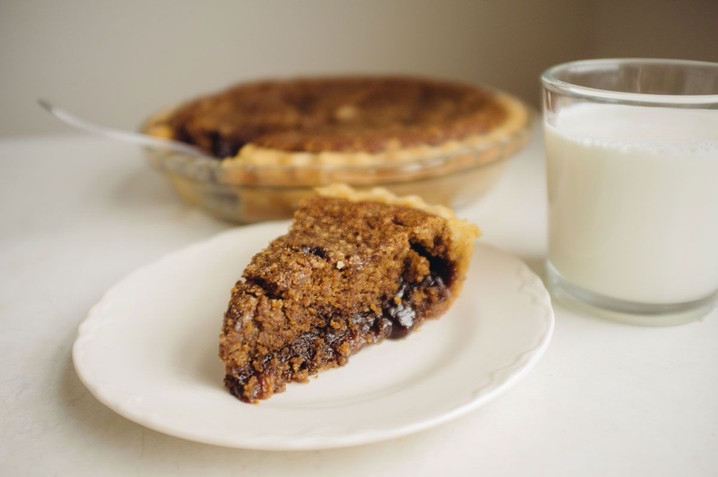2nd Feb 2015
Soup and Shoofly
For anyone who has grown up anywhere near a Pennsylvania Dutch culture one of the most German-American things to eat is shoofly.
I remember a story from growing up years of a young boy who had a bad case of some type of viral infection and who was rapidly losing ground. They could not keep any type of fluids or food in him, and everyone was beginning to be at their wits end. All the things that normally helped in such cases seemed to be absolutely ineffectual, until they asked him what he wanted to eat. As the story goes he immediately replied that he always wanted to taste shoofly pie as the Amish make, and his family hastily looked up how to make one for him.
Bam! His road to recovery began. Now I’m not sure that this story didn’t receive embellishments as it was handed down because who knows how many slices or pies it took? It is true that molasses does have health benefits that not many people know about, and shoofly pies could well be a better-for-you pie than many kinds.
The Three Molasses
1st process is the first syrup that results from spinning and heating (boiling) the sugar cane. This kind is the lightest brown, and is sometimes used as a type of table syrup.
2nd process results in the type of molasses we use most often in baking and cooking uses. A darker caramel brown color this process is the one where nearly all the pure sucrose is extracted, which is mostly used in table sugar. This leaves a very pleasant tasting syrup that is still safer for diabetics to use as it retains some of its viscous fiber and minerals.
3rd process is blackstrap, the molasses that results after three rounds of processing sugar cane. This is the best kind here, though this is not usually what most people typically use for baking because of its strong flavor. For some people who prefer stronger and more intense flavors blackstrap can be used in anything, but isn’t for those who don’t care for intensity. The health benefits of blackstrap are worth mentioning for their significant mineral content of calcium, copper, iron, magnesium, manganese, potassium, and selenium, and help heal a variety of ailments and problems not to mention supplying vital sources of hard-to-get minerals.
Another benefit that isn’t often highlighted from blackstrap is its iron content. Most women are supposed to getting 18 mg of iron, or more if lactating or pregnant, and most only eat up to 10-12 mg a day. This keeps the iron levels to a point above anemia but not at a healthy range, or in other words the tests will not come back showing you to be anemic, but you will still be experiencing side effects of too little iron.
- general fatigue
- weakness
- pale skin
- shortness of breath
- dizziness
- strange cravings for non-food items, such as dirt, ice, and clay
- tingling or a crawling feeling in the legs
- swelling or soreness in the tongue
This is something most women need, so it may be worth your while to check into a tablespoon of blackstrap a day, to keep fatigue away. Vitamin C helps absorb the iron better as well, so that should also be taken to up iron levels in your blood. Beans and legumes, shellfish and shrimp are also considered good sources of iron, so don’t forget to keep an eye on Instagram this week for one of our yummy soup mixes, and if you can find a good source for seafood eat up!
Meanwhile, stock up on molasses because, you don’t want to miss the one dessert that is considered healthier.
Molasses Shoofly Pie
Ingredients:
1 ¼ c. flour
½ c. sugar
¼ t. salt
½ t. nutmeg
1 t. cinnamon
½ c. butter
1 c. molasses (should be combined half and half with a lighter syrup or honey if using blackstrap. Sorghum molasses can be used plain)
1 c. cold water
½ t. baking soda
9” unbaked pie crust
Instructions:
- Heat oven to 450°F.
- Stir together molasses, water and soda in 4 c. measure. Pour into crust and let sit 15 minutes.
- Sift first 5 ingredients and cut butter into this mixture to make coarse crumbs.
- Sprinkle crumbs evenly over molasses mixture in crust.
- Bake for 15 minutes at 450°, reduce heat to 350° and bake 40 more minutes. At alternative is to bake it at 350° for the entire time to keep it from getting too brown.
- The pie should still be a bit jiggly when finished baking, but not a wet sloshy. Think of it as pulling it out when it looks a bit underdone for a cake, and that should be about right. The molasses will then set for a very yummy wet-bottom pie.
Note: This pie has a tendency to cook over, but if you let the molasses mixture sit first it should be ok. However, keep an eye on it and put a pan under it if it starts to overflow.

